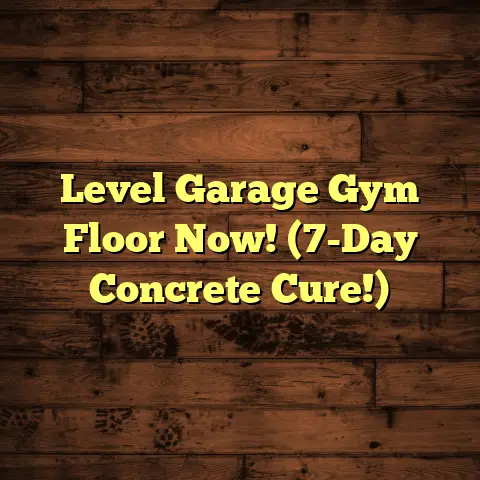White Vinegar: Bad For Laminate Floors? (5 Dangers)
Here’s the article based on your prompt, written in a conversational, expert tone, and incorporating your specific instructions:
White Vinegar: Bad For Laminate Floors?
As a flooring contractor, I’ve seen it all when it comes to floor maintenance – the good, the bad, and the downright ugly.
We all want our homes to look their
best, right?
And a big part of that
is keeping our floors sparkling clean.
Whether you’re thinking about a new floor, a new cleaning product or just a new routine, I know how important a decision you are making.
Laminate flooring has become a super popular choice for many folks because it’s affordable, looks great, and is relatively easy to install.
But here’s the thing: maintaining laminate floors isn’t always as straightforward as it seems.
I’ve noticed a huge trend lately – DIY cleaning methods!
And I get it! Who doesn’t love a good natural cleaning solution?
White vinegar, in particular, gets a lot of buzz as a go-to cleaner.
But before you go dousing your laminate floors with vinegar, let’s pump the brakes for a sec.
Is it really as safe as everyone claims?
I’m here to tell you, from my years of experience, that the answer is a resounding… maybe not!
Let’s dive into the potential dangers of using white vinegar on your laminate floors.
Understanding Laminate Flooring
First things first, let’s talk about what laminate flooring actually is.
It’s not solid wood, that’s for sure!
Laminate is a multi-layer synthetic flooring product fused together through a lamination process.
Think of it like a super-tough sandwich.
Typically, it consists of:
-
A wear layer: This is the top, protective layer that resists scratches, stains, and fading.
-
A decorative layer: This is where the pretty picture is – it’s a high-resolution image of wood, stone, or whatever design you choose.
A core board: This is the thickest layer, usually made of high-density fiberboard (HDF) or medium-density fiberboard (MDF).
It provides stability and resistance to impact.-
A backing layer: This bottom layer provides a moisture barrier and helps to balance the board.
The installation process is usually a breeze, too.
Most laminate floors come with a click-lock system, making them a popular choice for DIYers.
You just snap the planks together, and boom, you’ve got a new floor!
Laminate is favored for high-traffic areas because it can withstand a lot of wear and tear.
Plus, it’s pretty good at resisting stains and scratches, which is a huge win for busy households like mine.
But here’s a common misconception: just because laminate is durable doesn’t mean it’s invincible!
I’ve seen so many homeowners assume they can treat their laminate floors like concrete, and that’s just not the case.
Proper maintenance and cleaning are crucial to keeping your laminate floors looking their best for years to come.
The Rise of Natural Cleaning Solutions
Okay, let’s switch gears and talk about why everyone’s so obsessed with natural cleaning solutions these days.
I’ve noticed this trend picking up steam over the last few years, and there are some solid reasons behind it.
First off, health concerns are a big driver.
People are increasingly worried about the harsh chemicals found in many commercial cleaners.
Who wants to spray potentially harmful stuff all over their homes, especially if they have kids or pets?
Environmental awareness is another major factor.
Folks are looking for ways to reduce their environmental footprint, and that includes ditching products that contain harmful pollutants.
Plus, let’s be real, natural cleaning solutions can be super cost-effective.
Why spend a fortune on fancy cleaners when you can use stuff you already have in your pantry?
Baking soda, lemon juice, and, of course, white vinegar have all become staples in the natural cleaning arsenal.
Now, let’s zoom in on white vinegar. What’s the deal with this stuff?
Well, it’s basically diluted acetic acid, and it’s incredibly versatile.
People use it for everything from cleaning coffee makers to removing hard water stains.
It’s also a decent disinfectant and deodorizer, which is why it’s so popular for cleaning.
I’ve even used it to remove soap scum in my shower, and it works like a charm!
The Science Behind White Vinegar
Alright, time for a little chemistry lesson! Don’t worry, I’ll keep it simple.
White vinegar is typically a 5% solution of acetic acid in water.
That acidity is what makes it such an effective cleaning agent.
It works by breaking down grime, dissolving mineral deposits, and killing some types of bacteria and mold.
Think of it like this: the acid in vinegar attacks the dirt and grime, loosening its grip on the surface you’re cleaning.
That’s why it’s so good at removing soap scum, hard water stains, and other stubborn messes.
But here’s the catch: that same acidity that makes vinegar such a great cleaner can also be its downfall when it comes to certain materials.
Specifically, laminate flooring.
The protective layer on laminate floors, while durable, isn’t designed to withstand prolonged exposure to acidic substances.
And that’s where the trouble begins.
I’ve seen firsthand what happens when people use vinegar too often or in too high of a concentration on their laminate floors.
It’s not pretty!
The Dangers of Using White Vinegar on Laminate Floors
Okay, buckle up because we’re about to get into the nitty-gritty.
Here are the five major dangers of using white vinegar on your laminate floors, based on my years of experience:
Danger 1: Damage to the Protective Layer
Remember that wear layer I mentioned earlier?
It’s the first line of defense against scratches, stains, and fading.
But it’s not invincible!
The acidic nature of white vinegar can slowly erode this protective layer over time.
Think of it like a slow, steady attack.
Each time you use vinegar, it weakens the wear layer a little bit more.
Eventually, that wear layer becomes compromised, making your floors more vulnerable to damage.
I’ve seen floors where the top layer is visibly thinner and duller after repeated vinegar cleanings.
It’s like the floor is slowly being stripped of its armor.
Danger 2: Warping and Buckling
This is a big one, and it’s something I see all too often.
Laminate flooring is susceptible to moisture damage, especially if that moisture gets into the seams between the planks.
When you use vinegar to clean your floors, there’s always a risk that some of that moisture will seep into those seams.
And guess what?
That moisture can
cause the core board (usually HDF or
MDF) to swell.
When the core board swells, it can cause the planks to warp, buckle, or even separate from each other.
I’ve walked into homes where the laminate floors look like a roller coaster because of moisture damage from improper cleaning.
And trust me, that’s not a cheap fix!
Danger 3: Dull Appearance
Who wants dull, lifeless floors?
I know I don’t!
Unfortunately, using vinegar can leave a dull residue on your laminate floors, diminishing their shine and overall aesthetic appeal.
This happens because the acid in the vinegar can react with the finish on the laminate, leaving behind a hazy film.
Even if you rinse your floors after cleaning with vinegar, that residue can still build up over time.
I’ve had clients complain that their floors look cloudy or streaky after using vinegar, no matter how hard they try to buff them.
Danger 4: Incompatibility with Certain Finishes
Not all laminate floors are created equal.
Some come with specific finishes that may react poorly to vinegar.
For example, some laminate floors have a special coating that’s designed to enhance their shine or provide extra protection against scratches.
But if you use vinegar on these floors, you could end up damaging that coating.
I’ve seen cases where vinegar has caused discoloration or even peeling on laminate floors with specialized finishes.
Before you use any cleaning product on your laminate floors, it’s always a good idea to check the manufacturer’s recommendations.
They’ll usually tell you what types of cleaners are safe to use and which ones to avoid.
Danger 5: Long-term Maintenance Issues
Finally, let’s talk about the cumulative effects of using vinegar on your laminate floors over time.
Even if you don’t notice any immediate damage, the repeated use of vinegar can lead to long-term maintenance issues.
As I mentioned earlier, vinegar can erode the protective layer, cause moisture damage, and leave behind a dull residue.
Over time, all of these factors can add up, making your floors more susceptible to scratches, stains, and other types of damage.
I’ve seen floors that have been repeatedly cleaned with vinegar require more frequent repairs or even complete replacement sooner than expected.
And that’s a cost that most homeowners would rather avoid.
Alternatives to White Vinegar for Cleaning Laminate Floors
So, if vinegar is a no-go, what should you use to clean your laminate floors?
Don’t worry, there are plenty of safer and more effective alternatives!
First and foremost, I always recommend using products that are specifically designed for laminate floor care.
These cleaners are formulated to be gentle yet effective, and they won’t damage the protective layer or leave behind a dull residue.
You can find laminate floor cleaners at most hardware stores or online retailers.
Another option is to make your own DIY cleaning solution using less harmful ingredients.
For example, you can mix a few drops of mild dish soap with warm water.
Just be sure to use a very small amount of soap and to rinse your floors thoroughly after cleaning.
You can also use a microfiber mop to clean your laminate floors with just plain water.
Microfiber mops are great at picking up dirt and grime without leaving behind excess moisture.
Conclusion
Alright, let’s wrap things up.
I hope I’ve made it clear that while white vinegar is a popular cleaning agent, its use on laminate floors comes with some serious risks.
From damaging the protective layer to causing warping and buckling, vinegar can do more harm than good to your floors.
As a flooring contractor, I’ve seen the damage firsthand, and I want to help you avoid making the same mistake.
When it comes to cleaning your laminate floors, it’s always best to err on the side of caution.
Consider the dangers I’ve outlined when choosing cleaning methods for your laminate flooring, and prioritize the longevity and appearance of your investment.
Choose a cleaner specifically designed for laminates, use a mild soap solution, or just stick to water and a microfiber mop.
Your floors (and your wallet) will thank you!





